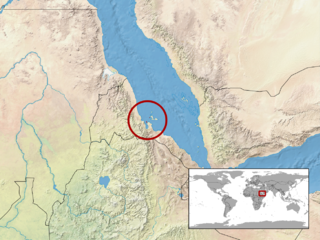
Echis carinatus, known as the saw-scaled viper, Indian saw-scaled viper, little Indian viper, and by other common names, is a viper species found in parts of the Middle East and Central Asia, and especially the Indian subcontinent. It is the smallest member of the "big four" Indian snakes that are responsible for causing the most snakebite cases and deaths, due to various factors including their frequent occurrence in highly populated regions, and their inconspicuous nature. Like all vipers, the species is venomous. Two subspecies are currently recognized, including the nominate subspecies described here.

Echis coloratus, known as the painted saw-scaled viper, painted carpet viper, Burton's carpet viper, and by other common names, is a highly venomous viper species endemic to the Middle East and Egypt. No subspecies are currently recognized.

Echis megalocephalus, also known commonly as the big-headed carpet viper and Cherlin's saw-scaled viper, is a species of venomous snake in the family Viperidae. The species is endemic to one island in the Red Sea off the coast of Eritrea. There are no subspecies that are recognized as being valid.

Astola Island also known as Jezira Haft TalarSatadip or 'Island of the Seven Hills', is a small uninhabited Pakistani island in the Arabian Sea approximately 25 km (16 mi) south of the nearest part of the coast and 39 km (24 mi) southeast of the fishing port of Pasni. Astola is Pakistan's largest offshore island at approximately 6.7 km (4.2 mi) long with a maximum width of 2.3 km (1.4 mi) and an area of approximately 6.7 km2 (2.6 sq mi). The highest point is 246 ft (75 m) above sea level. Administratively, the island is part of the Pasni subdistrict of Gwadar District in Balochistan province. The island can be accessed by motorized boats from Pasni, with a journey time of about 5 hours to reach the island. On August 4, 2020, Pakistan has released a new political map that for the first time shows the Islands of Churna and Astola.

Echis is a genus of vipers found in the dry regions of Africa, the Middle East, India, Sri Lanka and Pakistan. They have a characteristic threat display, rubbing sections of their body together to produce a "sizzling" warning sound. The name Echis is the Latin transliteration of the Greek word for "viper" (ἔχις). Like all vipers, they are venomous. Their common name is "saw-scaled vipers" and they include some of the species responsible for causing the most snakebite cases and deaths in the world. Twelve species are currently recognized.

Eristicophis is a monotypic genus created for the viper species, Eristicophis macmahonii, which is endemic to the desert region of Balochistan near the borders of Iran, Pakistan, and Afghanistan. Common names for the species include McMahon's viper, Asian sand viper, leaf-nosed viper, and whiskered viper. Like all other vipers, it is venomous. No subspecies are currently recognized.

Echis hughesi, known as the Hughes' carpet viper, Somali carpet viper, and Hughes' saw-scaled viper, is a species of venomous snake in the subfamily Viperinae of the family Viperidae. The species is endemic to Somalia. There are no subspecies which are currently recognized as being valid.
Echis jogeri, known as the Joger's carpet viper, Mali carpet viper, Joger's saw-scaled viper, is a species of venomous snake in the family Viperidae. The species is endemic to Mali. There are no subspecies which are recognized as being valid.

Echis leucogaster, also known as the white-bellied carpet viper or the Roman's saw-scaled viper, is a viper species endemic to West and Northwest Africa. Its scientific name derives from its white (leuco-), unmarked belly (gaster). like all other vipers, it is venomous. No subspecies are currently recognized.
Echis ocellatus, known by the common names West African carpet viper and ocellated carpet viper, is a highly venomous species of viper endemic to West Africa. No subspecies are currently recognized.

Echis pyramidum, known as the Northeast African carpet viper, Egyptian saw-scaled viper, and by other common names, is a species of viper endemic to Northeast Africa and the Arabian Peninsula. Like all other vipers, it is venomous. Three subspecies are currently recognized, including the nominate subspecies described here.

Echis carinatus multisquamatus, known as the multiscale saw-scaled viper and transcaspian saw-scaled viper, is a viper subspecies found in Uzbekistan, Turkmenistan, Iran, Afghanistan, and Pakistan. Like all other vipers, it is venomous.
Echis carinatus sinhaleyus is a venomous viper subspecies endemic to Sri Lanka.

Echis carinatus sochureki is a venomous viper subspecies found in India, Pakistan, Afghanistan, Iran, and parts of the Arabian Peninsula.
Echis pyramidum aliaborri is a venomous viper subspecies endemic to northern Kenya.
Echis pyramidum leakeyi is a venomous viper subspecies endemic to northern East Africa.

The fiery flying serpent is a creature mentioned in the Book of Isaiah in the Tanakh.

Craspedocephalus borneensis, commonly known as the Bornean pit viper, is a venomous pit viper species endemic to the island of Borneo. No subspecies are currently recognized.











